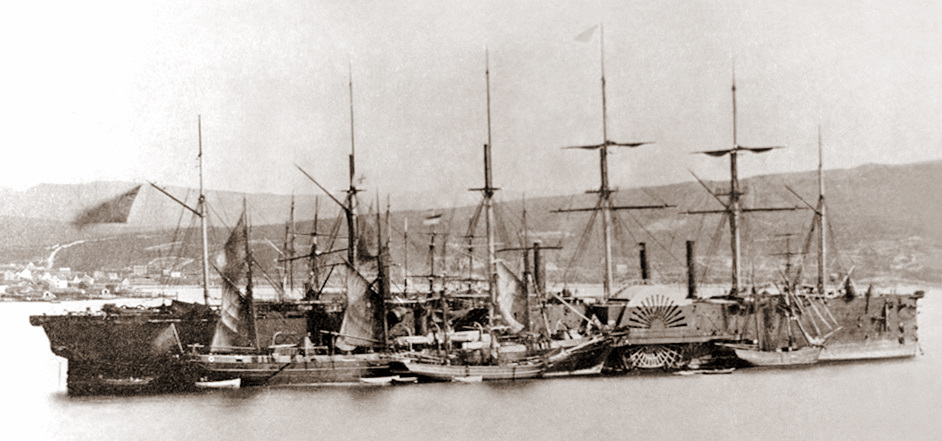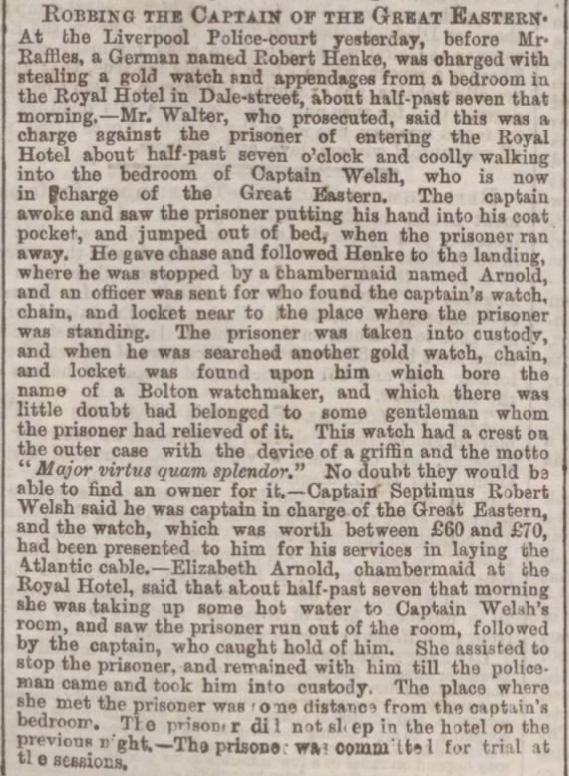Isambard Kingdom Brunell’s incredible ship the Great Eastern ship has its place in history, from carrying passengers, to laying undersea cables, to sailing with a combination of sails paddle-wheels and a propeller, is all fine and interesting, but what has this to do with Bolton and its Clockmakers?

The Captain Septimus Robert Welch, Captain of the Great Eastern was presented with a pocket watch in commemoration of laying the Atlantic Cable, that watch was made by a yet unidentified Bolton clockmaker.
The watch that was stolen was recovered, the thief Robert Henke was convicted at Liverpool Sessions.
The Manchester Courier and Lancashire General Advertiser 10th August 1867

Sentenced for six months for Larceny from a building, the watch worth £60-70 in 1857 is equivslent to about £8500-£10,000 today.
Sadly I haven’t yet identified the Watch or the Maker, but research continues.
Captain Septimus Robert Welch (1828-1876)
Septimus Robert Welch was a Master Mariner from London Born 8th November 1828 at Cumming Place Islington.
On 12th March 1859 his name was entered into the Royal Navy Reserve as a Lieutenant in the Navy List.
He lived in Club Moor, West Derby, Liverpool from when he married Helen Thacker on 16th April 1868 in St. Pancras London.
For many years their address was 22 Brecknock Crescent, Camden Town.
Captain Welch was a Fellow of the Statistical Society, and had been since elected at the 1874 meeting on November 17th.
He died on April 6th 1876, at his home in 16 Cambridge Gardens, Notting Hill. He was Buried in Camden London on 10th April 1876
The Great Eastern (1858-1888)

Science Museum Group Collection © The Board of Trustees of the Science Museum https://creativecommons.org/licenses/by-nc-sa/4.0/
Great Eastern was a huge steamship launched in 1858, designed by Isambard Kingdom Brunel.
It had an innovative metal hull, two paddle wheels and five funnels, and took four years to build. The ship had watertight compartments built into the hull, and was sail-powered, paddle wheel and screw-propelled. She was the largest ship in the world at the time.
Displacing 18,915 Gross Register Tonnage SS Great Eastern was enormous, it wasn’t until White Star Lines. RMS Celtic in 1901-03 that the tonnage was exceeded with its 20,904 Gross Register Tonnage.
At the time of the Great Eastern‘s launch she was the largest ship in the world. Sadly no dock or harbour in the world at the time was big enough to cope with her and she never became the great passenger ship she was intended to be.
In 1864, she was sold for a fraction of her cost to a cable laying company. She was used to lay the first telegraph cable to America, and finally broken up in 1888. The ship was built so strongly that it took 200 men two years to take it to pieces